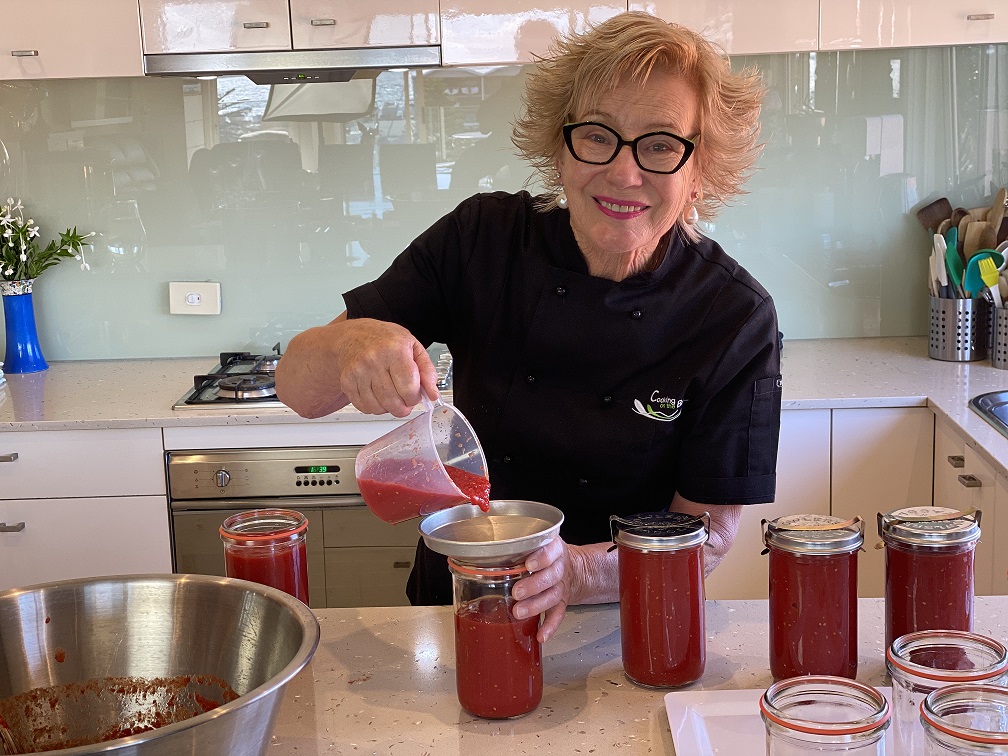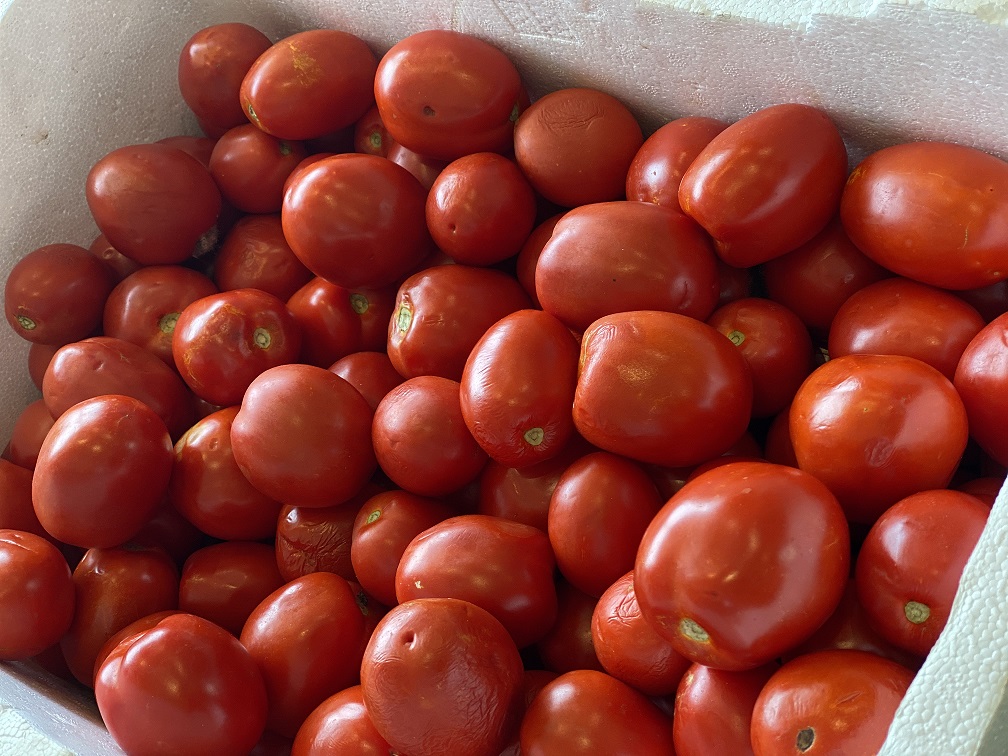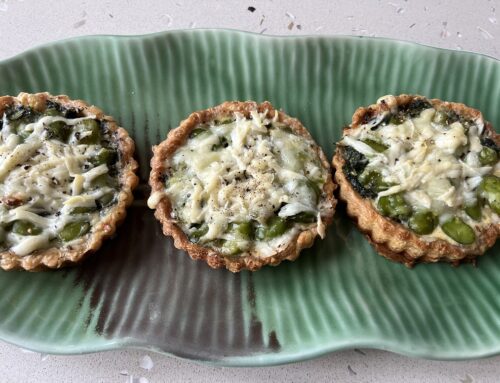Now, in February and March, is the perfect time for Passata making. Tomatoes are at their peak. It is an easy process – here is how to make it!
Ingredients:
To make 12 x 750 ml bottles
1 box of Roma ‘sauce’ tomatoes, about 15kg
Bunch basil
Murray River Sea Salt flakes
See recipe notes for the equipment required
Method:
I keep it simple; I add a fresh basil leaf, washed and dried, plus 1 teaspoon of Murray River sea salt flakes per bottle of passata. When using the passata, it is then that I add the onion, garlic, extra basil, oregano, or whatever other flavourings you may like.
Be prepared and start thinking of your passata making when the tomato season is at its peak, usually between February and March for us in Australia. Check your sauce bottles, and other equipment; buy what is necessary, such as a good pair of heavy-duty rubber gloves. Your old ones may have perished!
A week before your passata-making day, ask your market stall-holder or greengrocer to order your tomatoes. Vine-ripened Roma tomatoes are good at this time. My fruiterers, Gino and Joe, from Frank’s Quality Fruits at the South Melbourne market, recommend a special, small Roma ‘sauce’ tomato which has great colour, depth of flavour and fresh taste. So it is especially good for passata making.
The passata making process is simple:
- Place large pot of water on the stove and bring to the boil
- Sort tomatoes – discard mouldy ones and those too badly bruised or softened
- Wash tomatoes
- Add tomatoes to the large pot of boiling water
- Bring water back to the boil
- Simmer 10 minutes
- Drain – remove tomatoes from pot
- Allow to cool; squeeze out excess water and tip tomatoes into the tea-towel lined colander
- Drain for about 10 minutes
- Process through the mouli
- Bottle
- Sterilise in the preserver
One kilogram of tomatoes will make about one 750ml bottle of passata. Check the weight of the boxes; a box weighing 15 kilograms, will make about 12 x 750ml bottles.
To prepare the jars: the jars and lids need to be washed in hot soapy water or in the dishwasher, rinse well with hot water; dry well. These passata jars, do not need to be sterilised, as we do in jam and preserve making; the jars are sterilised during the preserving process. For the Flowers Vacola jars, you need to add the rubber rings to the rim of each jar. Place the rings in a bowl of warm water for 15 minutes, and fit the wet rings to the jars, evenly in the groove at the top of the jar. Run your fingers around the rm to ensure proper sealing and check to ensure the ring is not twisted.
To set-up: place a large pot of water over high heat and bring to the boil, ready for the tomatoes.
To prepare the boiler: if you do not have an electric preserving boiler, such as my Fowlers Vacola preserving unit, you will need to use a large, heavy-based pot with sides high enough to allow the water to cover your jars by 1 cm. Place an old, clean tea towel or cloth on the base of the large pot, fill with hot water and set over a flame and heat to about 38℃.
For those using the professional Fowlers Vacola preserving unit, follow the steps at the end of these instructions*.
To prepare the tomatoes: sort tomatoes; discard those which are very badly blemished, those with mould and those too badly bruised. Leave the tomatoes in single layers on trays in a warm place for a few days before hand to bring out the best flavours. If the tomatoes are nicely ripe, you can omit this step.
To wash the tomatoes: fill the kitchen sink with cold water, add a good slosh of household white vinegar, carefully wash tomatoes to remove any dirt or grit. Some people, remove the cores and slit the skin with a sharp paring knife. I do not.
Cook the tomatoes: bring the pot of water to the boil, add the tomatoes in medium sized batches, depending on your pot size! I put my tomatoes into a pillow slip for easy immersing and removing from the pot. Add pillow-slipped tomatoes to the pot and return water to the boil. When boiling, simmer for 10 minutes, to loosen the skins and cook the flesh a little; the tomatoes will soften and the skins will just split a little.
Using heavy-duty rubber gloves, remove the pillow sip from the water and squeeze out as much water as you can. Place the pillow slip into a tea towel-lined colander over a large pot. Gently twist the tea towel to extract the water; you are not extracting the tomato juices. Leave to cool a little, ready for mouli-ing.
To make the passata: in small batches, place a quantity of tomatoes in the bowl of your mouli then turn the handle to start the process. The machine squeezes the ripe tomatoes to extract the juice and separate the liquid pulp from the skins and seeds.
Have a large, clean bowl under mouli to catch the pulp and juice as it is squeezed.
Scrape the leftover skin and seeds out of the mouli and pass these through the mouli machine, a second time, to extract more juice, then discard. You may need to add some extra tomato liquid to this step; if the pulp is too dry, it may clog the sieving process. The extra juice will help the seeds and skins to go through more easily. This second pressing is what gives the passata extra colour, flavour and thickness. The fruiter Joe says the cores also give extra flavour!
In a large receptacle, pot or bucket, mix together all the passata distribute the puréed juices and pulp evenly.
To bottle the passata: in each clean, sterilised jar, place a teaspoon of Murry River sea salt flakes; ½ teaspoon for 500ml and 1 teaspoon for 750ml. Add a large basil or oregano leaf, or 2, into the base of each. Pour the tomato passata into the jars, using a wide-mouthed funnel, leaving 1 cm of head space at the top of each bottle.
Place lids on the jars and fit clips. The clips need to be in the middle position across the centre of the lid. Press lid and clip down firmly to seal. For other bottles, seal them using a capping machine or if using jars, tightly screw on the sterilised lids.
Place the sealed jars into the preserver. Fill with cold water.
Switch the preserving unit on to 92℃, and set the timer to required time, 75 minutes for my size 31 jars.
As soon as time is up, remove the jars with the tongs or thick rubber gloves, and place onto a board covered with tea towels or cake-cooler, leaving space around the bottles for air to circulate around each bottle. Check to see that the cover and clip are still square and firm, by pressing down on the centre of each cover. Leave the clips on.
Cool the jars at room temperature for 12-18 hours with the clips left on; remove clips and check the vacuum seal. Wipe jars clean with a damp cloth and label with name and date.
Store in a cool, dark place, away from the kitchen heat.
For those sterilising in a pot on the stove-top: put a thick tea-towel at the bottom of your large preserving pot and bring the water to 38℃. Gradually bring to a simmer, 90℃ and cook for 20 – 30 minutes. Turn off the heat and leave the bottles in the pot for 10 minutes. Remove the bottles, with the tongs or heavy duty, heat resistant gloves, and carefully place onto tea towels to cool. Do not tighten the lids any further.
Allow the bottles to cool and as they cool, the lids will pop, indication that the jar are fully sterilised and ready for storage. Wipe the bottles clean with a damp cloth. Re-secure the lids. Label carefully with their name and date. Store them in a cool, dark place.
Passata can also be used immediately; it will keep for up to three years.
When using the passata, it is best to cook it lightly, so you don’t lose the freshness of the puree.
For sourcing the tomatoes: I buy my tomatoes from my fruit and vegetable suppliers, Joe and Gino from Frank’s Fruits at the South Melbourne market.
My Italian friends, Van and Livia Vidotto, buy their Roma tomatoes from Bakaloumas Fresh Fruit and Vegetable Market – 218 Old Dandenong Rd, Heatherton VIC 3202; there is no website.
For those of you who can grow your own, there is special French heirloom tomato called ‘Rouge de Marmande’, (Lycopersicon Esculentum), from the Dordogne and it is available in Australia. It has a strong flavour with very few seeds. It grows in clusters of deep red, slightly flattened, ribbed fruits that are up to 9 cm across. It is disease and pest resistant and will grow in cooler climates.
Equipment: Chopping boards, paring knife, tea towels, jars, bottles and lids, large pots, strainer or spider, Fowlers’ Vacola or a large boiler for the sterilising plus a thermometre, Fowler Vacola tongs, and or heat proof gloves
Domestic mouli for small quantities of tomatoes. For large quantities, there are larger moulis and electric models available. For making a huge family batch, a tomato press, either manual or electric, would be great.
A large sauce funnel.
750ml glass jars. I use my Fowlers Vacola, size 31 jars; alternatively, you can select tomato passata jars from various suppliers, such as Home make it, in Oakleigh.
2 – 3large stock pots.
Suppliers:
Costante imports: 377-379 Bell Street, Preston, 03 9484 7948 – www.costanteimports.com.au; sales@costanteimpports.com.au
Cellar Plus: 106-110 Peel Street, North Melbourne, 03 9328 1843 – www.cellarplus.com.au
Home make it: 4/158 Wellington Road, Clayton VIC 3168; Clayton: 03 9574 8222 and Head Office 03 9487 1130 – info@homemakeit.com.au
Seeding vs. Not Seeding Tomatoes from Cook’s Illustrated’s research – https://www.cooksillustrated.com/how_tos/5866-seeding-vs-not-seeding-tomatoes
‘Do tomato seeds turn fresh tomato sauce bitter?’ Some cooks such as Stephanie Alexander, have said that cooked tomato seeds are bitter; my Italian friends and various sources are not worried by the tomato seeds in their passatas and sauces.
Cook’s Illustrated said: ‘Many recipes for tomato sauce call for first seeding the tomatoes, a process that can be a chore for large batches. To see if skipping this step would leave us with a bitter sauce, we compared a batch of tomato sauce in which we had seeded beefsteak tomatoes with one in which we hadn’t. In the past, we’ve found that the gel surrounding the seeds is rich in savory glutamates (more glutamates, even, than the flesh of the tomato), so we pushed the guts from the seeded tomatoes through a fine-mesh strainer, ensuring that only the seeds were left behind and preserving the gel. Out of curiosity, we sampled the raw seeds straight up and found them to be completely benign.
Forty minutes of simmering in the sauce didn’t change a thing; our tasters still detected no bitterness in the tomatoes and in fact found the sauces identical in flavor. Since the seeds don’t harm the flavor and removing them is a hassle, we’ll be leaving them in. If you choose to remove the seeds for aesthetic reasons, be sure to strain off and use the flavourful gel that surrounds them.’
- Tomatoes ready
- Washing and sorting
- Processing through the mouli
- Bottling with basil and sea salt










